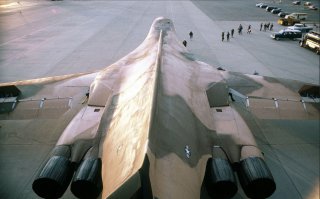The B-1 Lancer Bomber: Built to Kill Millions with Nuclear Weapons
The B-1 proved to be popular in Afghanistan, where its combination of high speed, long-range, and high payload capacity meant that it could serve as a ground-attack-support platform, despite being originally designed as a nuclear bomber.
The B-1 Lancer is an impressive long-range, supersonic heavy bomber with variable-geometry wings designed for both supersonic and subsonic speed. Its nickname is The Bone.
New Engines
General Electric developed a new turbofan design for the Lancer that has an afterburner, meaning the airframe can dump additionally fuel into the rear of the engine for greatly increased thrust, albeit at a cost — greatly increased fuel consumption.
The B-1 has four of these GE afterburning turbofan engines for a combined total of 123,000 pounds of thrust, which propels the B-1 to Mach 1.2.
Using its variable-geometry wings, the B-1 can sweep its wings back for high altitude, supersonic flight, or fly low, with wings outstretched while hugging the ground. This was the B-1’s secret weapon.
By flying low to the ground, the B-1 would be able to slip under Soviet air defense radars, which would be unable to distinguish the movement and the size of the B-1 from another movement near the ground.
Upgrades
The B-1 proved to be popular in Afghanistan, where its combination of high speed, long-range, and high payload capacity meant that it could serve as a ground-attack-support platform, despite being originally designed as a nuclear bomber.
Although the planned B-21 Raider stealthy bomber will replace the B-1, an upgrade to the airframe’s displays and communications in 2015 will keep the B-1 flying for at least another decade.
Bumpy Ride
A B-1 pilot said of flying low, "It's abrupt. It was created to have us sneak in low below enemy radars into Russia during the Cold War, employ nuclear weapons, and get out,” although it was not at all a gentile ride.
“It's not soft, not smooth," the pilot said about the low-flight mode. “The up-and-down motion in the B-1 felt more like a roller coaster — making me feel weightless at times or my breakfast coming up at others (still, I kept it down).”
High-Flying Only
Late in 2019, B-1s were restricted from a low-level flight, their signature ability. The reason was stress, lots of stress.
Not pilot stress, but stress on the airframe. The B-1s low-light mode, otherwise known as TERFLW mode (low-altitude, terrain-following) has put a great deal of stress on the airframe.
The low-level flight is harder on a plane’s airframe than high altitude flight. Up high the atmosphere is thinner, and a plane can glide through the sky with less resistance. Down below, at lower altitudes, the air is thicker, and turbulence is more likely. Although not forbidden, B-1s likely won’t use TERFLW mode anytime soon.
Still, take the opportunity to enjoy this video of a B-1 Lancer flying at about 500 feet.
Caleb Larson is a defense writer for the National Interest. He holds a Master of Public Policy and covers U.S. and Russian security, European defense issues, and German politics and culture.

